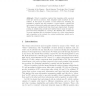Free Online Productivity Tools
i2Speak
i2Symbol
i2OCR
iTex2Img
iWeb2Print
iWeb2Shot
i2Type
iPdf2Split
iPdf2Merge
i2Bopomofo
i2Arabic
i2Style
i2Image
i2PDF
iLatex2Rtf
Sci2ools
IBPRIA
2007
Springer
2007
Springer
Invariant Multi-scale Object Categorisation and Recognition
Object recognition requires that templates with canonical views are stored in memory. Such templates must somehow be normalised. In this paper we present a novel method for obtaining 2D translation, rotation and size invariance. Cortical simple, complex and end-stopped cells provide multi-scale maps of lines, edges and keypoints. These maps are combined such that objects are characterised. Dynamic routing in neighbouring neural layers allows feature maps of input objects and stored templates to converge. We illustrate the construction of group templates and the invariance method for object categorisation and recognition in the context of a cortical architecture, which can be applied in computer vision.
| Added | 07 Jun 2010 |
| Updated | 07 Jun 2010 |
| Type | Conference |
| Year | 2007 |
| Where | IBPRIA |
| Authors | João Rodrigues, J. M. Hans du Buf |
Comments (0)

